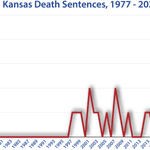
State & Federal
Kansas

Timeline
1907 — Governor Hoch abolishes Kansas’ death penalty for the first time.
1935 — The death penalty is reinstated in Kansas.
1965 — George York and James Latham are executed in a double hanging. These are the last executions Kansas has carried out to date.
1979 – 1985 — The Kansas State Legislature attempts to reinstate the death penalty, but Governor Carlin vetoes reinstatement legislation during this period.
1994 — The current Kansas death penalty statute is enacted once Governor Finney allowed it into law without her signature.
1995 — The Kansas legislature abolishes the affirmative insanity defense which allowed a defendant to be acquitted if they did not understand the difference between right and wrong at the time of their crime.
2001 — In State v. Kleypas, the Kansas Supreme Court ruled that the state statute, which allowed the imposition of the death penalty when mitigating and aggravating factors were of equal weight, is unconstitutional under the 8th amendment.
2006 — In Kansas v. Marsh, the U.S. Supreme Court holds that the Kansas death penalty statute does not violate the 8th amendment, reversing the Kansas Supreme Court’s decision in State v. Kleypas. As long as juries are able to consider all of the relevant mitigating evidences, states can require the death penalty when aggravating and mitigating factors are equally balanced.
2013 — In Kansas v. Cheever, the Kansas Supreme Court determines that the Fifth amendment does not prevent the prosecution from introducing psychiatric evidence to rebut psychiatric evidenced presented by the defense.
2016 — In Kansas v. Carr, the U.S. Supreme Court reverse the decisions of the Kansas Supreme Court, restoring the death sentences of Jonathan Carr, Reginald Carr, Jr., and Sidney Gleason. The Kansas Supreme Court had vacated the men’s death sentences because the jury was not informed that mitigating factors presented during the sentencing proceedings to spare a defendant’s life do not need to be proven beyond a reasonable doubt.
2020 — In Kahler v. Kansas, the U.S. Supreme Court holds that Kansas’ approach towards providing for an insanity defense based on mental disease or defect does not violate due process. The state is not required to adopt an insanity test to determine a defendant’s understanding of right and wrong at the time of the crime.
2022 — The Kansas Supreme Court affirms the death sentences of Jonathan and Reginald Carr, concluding that the Kansas constitution does not stipulate that the inalienable right to life and liberty could not be forfeited.
Famous Cases
The Clutter Family
The murders of Herbert Clutter, his wife and two of his children in Holcomb became one of Kansas’ most famous cases when Truman Capote chronicled the murders and the trial in his 1966 book, “In Cold Blood.”
Richard “Dick” Hickok and Perry Smith, two parolees, were convicted of the murders. They were both executed by hanging on April 14, 1965.
Michael Marsh
Marsh was convicted and sentenced to death for the killings of Marry Ane and Marry Elizabeth Pusch in 1996. The Kansas Supreme Court ruled that the death penalty statute was unconstitutional because of its requirement that, when a jury finds during a sentencing hearing that the mitigating and aggravating factors are equal, they must choose death.
The US Supreme Court overturned this decision in June 2006. Justice Scalia wrote a concurring opinion in this case where he claimed:
“It should be noted at the outset that the dissent does not discuss a single case — not one — in which it is clear that a person was executed for a crime he did not commit. If such an event had occurred in recent years, we would not have to hunt for it; the innocent’s name would be shouted from the rooftops by the abolition lobby.”
See DPIC’s webpage Executed But Possibly Innocent for examples of cases in which likely innocent death-row prisoners have been executed.
Notable Exonerations
While there have been no death penalty exonerations in Kansas, there have been notable felony exonerations including the cases of Olin “Pete” Coones, Lamonte McIntyre, Floyd Bledsoe, Eddie James Lowery and Joe Jones.
• Olin “Pete” Coones was convicted of two murders in 2009, despite strong evidence that pointed to a murder-suicide and no physical evidence linking Coones to the crime. Witnesses also placed Coones at his home during the time in which the crime was committed, unable to even leave the house. The only evidence that linked Coones to the killings was an ongoing legal dispute with one of the victims, Kathleen Scholl, and a phone call that Scholl had placed right before the deaths to her mother that implicated Coones. Coones’s trial was rife with prosecutorial misconduct. Despite this, it took over 10 years for Coones to be exonerated and released from prison. Coones died three months after his release.
• Lamonte McIntyre was convicted of two counts of first-degree murder in 1994, after two eyewitnesses identified McIntyre as the perpetrator, despite no evidence of McIntyre’s connection to the victims, no motives for the killings, or any physical evidence linking McIntyre to the crime. In the years following McIntyre’s conviction, evidence of official and prosecutorial misconduct was revealed, including that the lead prosecutor and detective elicited false identification and witness testimony. A romantic relationship between the lead prosecutor and judge was also not disclosed to the defense. After more than 20 years in prison, McIntyre’s conviction was vacated and the charges dismissed in 2017.
• Floyd Bledsoe was convicted of murder, child sex abuse, and the 2000 kidnapping of his wife’s teenage sister after his brother, Tom Bledsoe, accused him of the crimes. His brother had earlier confessed to the crimes and turned himself in but changed his story only once in custody. While there was no forensic evidence linking Floyd to the crime, his defense proved to be inadequate, as seen in their failure to confront Tom’s hearing problems, which could bring into question Floyd’s alleged confession to his brother, as well as the inclusion of statements from Floyd’s two-year-old son. There was also evidence of misconduct, as officials signed an order to not conduct any DNA testing on the evidence. After several failed appeals, Floyd Bledsoe was released and exonerated in 2015 after DNA testing identified Tom as the perpetrator, not Floyd. Shortly thereafter, Tom committed suicide, leaving behind several notes confessing to the crime.
• Eddie James Lowery was convicted of rape in 1982 after he falsely confessed to a crime he did not commit. Lowery was questioned for an entire day with no food and no rest, and was not provided a lawyer when he requested one. Under duress, he confessed to the rape hoping to be found innocent during his trial. Instead, because he was not under arrest at the time, the court allowed his false confession to be used in the trial. He was paroled after nearly 10 years, and was not exonerated by DNA evidence until 2002.
• Joe Jones was convicted of kidnapping, assault and rape in 1986 and given a life sentence. The victim identified a different man when presented with a photo array, but identified Jones as her rapist in person. Jones was exonerated by DNA evidence in 1992 after court officials allowed the rape kit to be tested.
Notable Commutations/Clemencies
Before his term ended, Governor George Docking (1957 – 1960) commuted the sentences of two of the five inmates on death row, Earl Wilson and Bobbie Joe Spencer. Governor Docking was also responsible for a hiatus in Kansas executions between 1954 and 1960. The only executions that took place in Kansas during those years were at the US Army and Air Force Disciplinary Barracks.
Milestones in Abolition/Reinstatement
• The Kansas death penalty has been abolished and reinstated three times. The state’s death penalty was first abolished on January 30, 1907 by Governor Hoch. For that reason, January 30 is celebrated by KCADP as “Abolition Day” in Kansas.
• In 1935, the death penalty was reinstated, but no executions took place under the law until 1944. Kansas had this death penalty statute in effect until the 1972 US Supreme Court ruling that struck down the death penalty.
• After the 1976 US Supreme Court rulings that upheld the constitutionality of several states’ death penalty statutes, the Kansas legislature made numerous attempts to reinstate the death penalty. Governor Carlin vetoed reinstatement legislation in 1979, 1980, 1981, and 1985. The current death penalty statute was enacted in 1994 when Governor Finney allowed it to become law without her signature.
• In 2010, the Kansas Senate was one vote short of voting to replace the death penalty with life without the possibility of parole for the crime of aggravated murder.
Other Interesting Facts
• Of states that still allow the death penalty, Kansas was the last state to reinstate the death penalty in the modern era. (New York reinstated its death penalty in 1995, but abolished it in 2007.)
• Kansas has not executed anyone since 1965.
• The U.S. Military’s death row is located at the U.S. Disciplinary Barracks in Fort Leavenworth, Kansas.

Resources

Kansas Execution Totals Since 1976
News & Developments
News
Jun 04, 2025
2025 Roundup of Death Penalty Related Legislation
More than one hundred bills have been introduced this year in 34 states and in Congress to expand and limit use of the death penalty, abolish and reinstate the death penalty, modify execution protocols and secret the information about them, and alter aspects of capital trials. Thus far, nine bills in five states have been enacted, with Florida enacting the most legislation. Of the bills that have been signed into law, three modify execution protocols; two expand…
Read MoreNews
May 19, 2025
District Court Judge Calls Kansas Death Penalty Racially Biased, Costly, and Ineffective as a Deterrent
On April 16, 2025, Wyandotte County District Judge Bill Klapper issued his order in the combined cases of Hugo Villaneuva-Morales and Antoine Fielder, broadly condemning the Kansas death penalty as costly, racially biased, and ineffective as a deterrent. Judge Klapper’s order follows an extensive evidentiary hearing and provides thorough and detailed findings on an array of constitutional questions related to the use of the death penalty in the state. Mr.
Read MoreNews
Oct 29, 2024
Hearings Begin on Constitutional Challenge to Kansas’ Death Penalty and Capital Jury Selection Process
“If you are charged with capital murder … you are less likely to get…
Read MoreNews
Aug 19, 2024
Kansas City Star Op-Ed Describes the Death Penalty as the “Ultimate Failed Big-Government Program” and Calls for Abolition
Senator Carolyn McGinn (left) and Kelson Bohnet…
Read MoreNews
Jan 20, 2023
Kansas Capital Defendant Moves to Bar Death Penalty, Invoking State Constitution’s ‘Strict Scrutiny’ For Life and Liberty Issues
A Kansas capital defendant is challenging the prosecution’s decision to pursue the death penalty in his case, invoking a heightened standard of review the Kansas constitution applies to infringements of fundamental…
Read More

